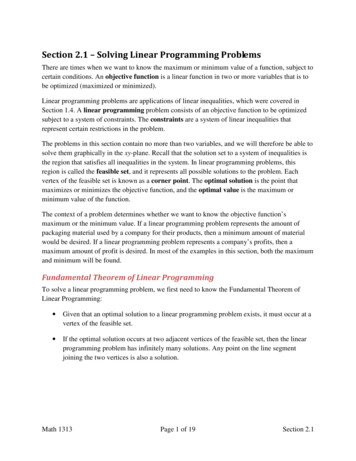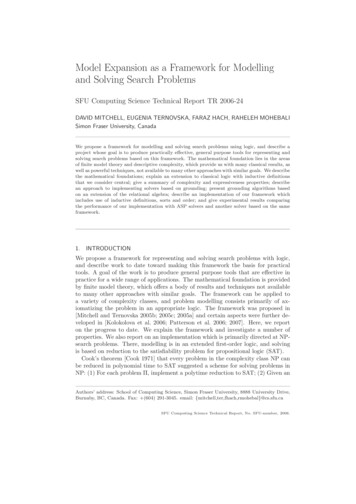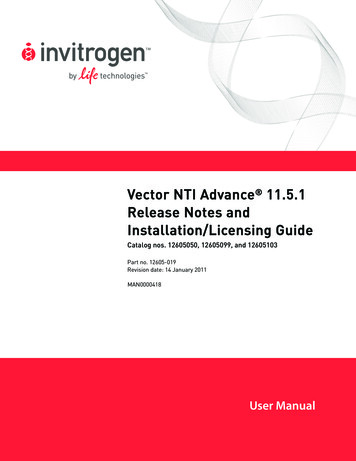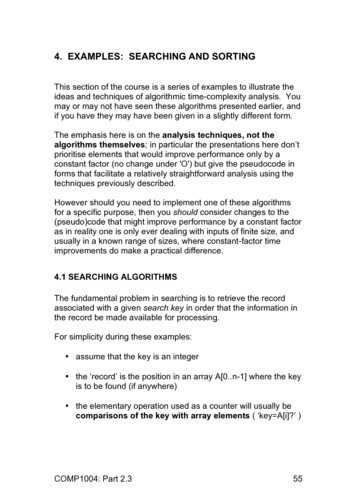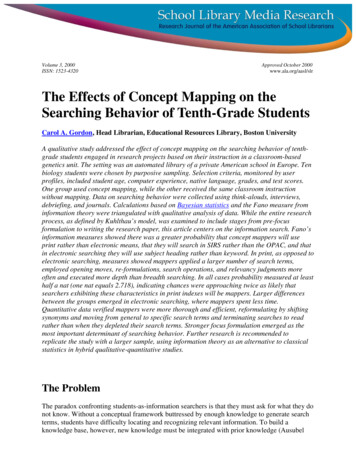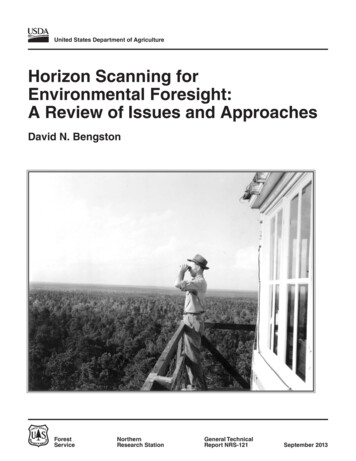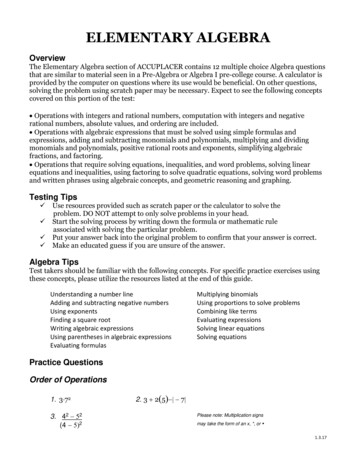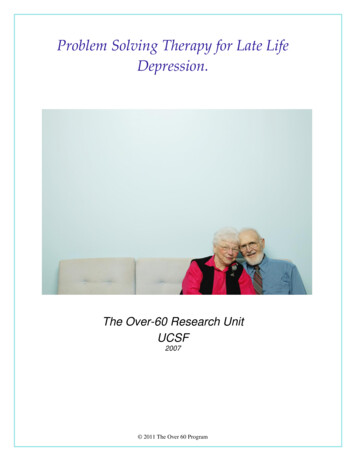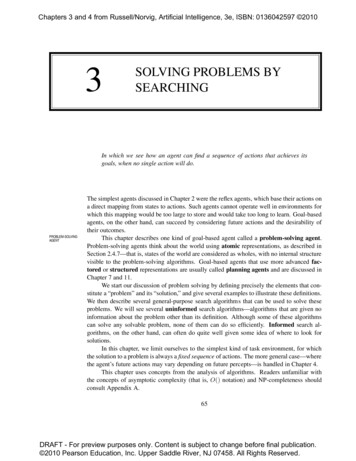
Transcription
Chapters 3 and 4 from Russell/Norvig, Artificial Intelligence, 3e, ISBN: 0136042597 20103SOLVING PROBLEMS BYSEARCHINGIn which we see how an agent can find a sequence of actions that achieves itsgoals, when no single action will do.PROBLEM-SOLVINGAGENTThe simplest agents discussed in Chapter 2 were the reflex agents, which base their actions ona direct mapping from states to actions. Such agents cannot operate well in environments forwhich this mapping would be too large to store and would take too long to learn. Goal-basedagents, on the other hand, can succeed by considering future actions and the desirability oftheir outcomes.This chapter describes one kind of goal-based agent called a problem-solving agent.Problem-solving agents think about the world using atomic representations, as described inSection 2.4.7—that is, states of the world are considered as wholes, with no internal structurevisible to the problem-solving algorithms. Goal-based agents that use more advanced factored or structured representations are usually called planning agents and are discussed inChapter 7 and 11.We start our discussion of problem solving by defining precisely the elements that constitute a “problem” and its “solution,” and give several examples to illustrate these definitions.We then describe several general-purpose search algorithms that can be used to solve theseproblems. We will see several uninformed search algorithms—algorithms that are given noinformation about the problem other than its definition. Although some of these algorithmscan solve any solvable problem, none of them can do so efficiently. Informed search algorithms, on the other hand, can often do quite well given some idea of where to look forsolutions.In this chapter, we limit ourselves to the simplest kind of task environment, for whichthe solution to a problem is always a fixed sequence of actions. The more general case—wherethe agent’s future actions may vary depending on future percepts—is handled in Chapter 4.This chapter uses concepts from the analysis of algorithms. Readers unfamiliar withthe concepts of asymptotic complexity (that is, O() notation) and NP-completeness shouldconsult Appendix A.65DRAFT - For preview purposes only. Content is subject to change before final publication. 2010 Pearson Education, Inc. Upper Saddle River, NJ 07458. All Rights Reserved.
Chapters 3 and 4 from Russell/Norvig, Artificial Intelligence, 3e, ISBN: 0136042597 2010663.1Chapter3.Solving Problems by SearchingP ROBLEM -S OLVING AGENTSGOAL FORMULATIONPROBLEMFORMULATIONIntelligent agents are supposed to maximize their performance measure. As we mentionedin Chapter 2, achieving this is sometimes simplified if the agent can adopt a goal and aim atsatisfying it. Let us first look at why and how an agent might do this.Imagine an agent in the city of Arad, Romania, enjoying a touring holiday. The agent’sperformance measure contains many factors: it wants to improve its suntan, improve its Romanian, take in the sights, enjoy the nightlife (such as it is), avoid hangovers, and so on. Thedecision problem is a complex one involving many tradeoffs and careful reading of guidebooks. Now, suppose the agent has a nonrefundable ticket to fly out of Bucharest the following day. In that case, it makes sense for the agent to adopt the goal of getting to Bucharest.Courses of action that don’t reach Bucharest on time can be rejected without further consideration and the agent’s decision problem is greatly simplified. Goals help organize behaviorby limiting the objectives that the agent is trying to achieve and hence the actions it needsto consider. Goal formulation, based on the current situation and the agent’s performancemeasure, is the first step in problem solving.We will consider a goal to be a set of world states—exactly those states in which thegoal is satisfied. The agent’s task is to find out how to act, now and in the future, so that itreaches a goal state. Before it can do this, it needs to decide (or we need to decide on itsbehalf) what sorts of actions and states it should consider. If it were to consider actions atthe level of “move the left foot forward an inch” or “turn the steering wheel one degree left,”the agent would probably never find its way out of the parking lot, let alone to Bucharest,because at that level of detail there is too much uncertainty in the world and there would betoo many steps in a solution. Problem formulation is the process of deciding what actionsand states to consider, given a goal. We will discuss this process in more detail later. For now,let us assume that the agent will consider actions at the level of driving from one major townto another. Each state therefore corresponds to being in a particular town.Our agent has now adopted the goal of driving to Bucharest, and is considering whereto go from Arad. There are three roads out of Arad, one toward Sibiu, one to Timisoara, andone to Zerind. None of these achieves the goal, so unless the agent is very familiar with thegeography of Romania, it will not know which road to follow.1 In other words, the agent willnot know which of its possible actions is best, because it does not yet know enough about thestate that results from taking each action. If the agent has no additional information—i.e., ifthe environment is unknown in the sense defined in Section 2.3—then it is has no choice butto try one of the actions at random. This sad situation is discussed in Chapter 4.But suppose the agent has a map of Romania. The point of a map is to provide theagent with information about the states it might get itself into, and the actions it can take. Theagent can use this information to consider subsequent stages of a hypothetical journey viaeach of the three towns, trying to find a journey that eventually gets to Bucharest. Once it has1We are assuming that most readers are in the same position and can easily imagine themselves to be as cluelessas our agent. We apologize to Romanian readers who are unable to take advantage of this pedagogical device.AIMA3e c 2008 by Russell and Norvig.DRAFT---DO NOT DISTRIBUTEDRAFT - For preview purposes only. Content is subject to change before final publication. 2010 Pearson Education, Inc. Upper Saddle River, NJ 07458. All Rights Reserved.
Chapters 3 and 4 from Russell/Norvig, Artificial Intelligence, 3e, ISBN: 0136042597 2010Section g Agents67found a path on the map from Arad to Bucharest, it can achieve its goal by carrying out thedriving actions that correspond to the legs of the journey. In general, an agent with severalimmediate options of unknown value can decide what to do by first examining future actionsthat eventually lead to states of known value.To be more specific about what we mean by “examining future actions,” we have to bemore specific about properties of the environment, as defined in Section 2.3. For now, wewill assume that the environment is observable, so that the agent always knows the currentstate. For the agent driving in Romania, it’s reasonable to suppose that each city on the maphas a sign indicating its presence to arriving drivers. We will also assume the environmentis discrete, so that at any given state there are only finitely many actions to choose from.This is true for navigating in Romania because each city is connected to a small numberof other cities. We will assume the environment is known, so that the agent knows whichstates are reached by each action. (Having an accurate map suffices to meet this conditionfor navigation problems.) Finally, we assume that the environment is deterministic, so thateach action has exactly one outcome. Under ideal conditions, this is true for the agent inRomania—it means that if it chooses to drive from Arad to Sibiu, it does end up in Sibiu. Ofcourse, conditions are not always ideal, as we will see in Chapter 4.Under these assumptions, the solution to any problem is a fixed sequence of actions.“Of course!” one might say, “What else could it be?” Well, in general it could be a branchingstrategy that recommends different actions in the future depending on what percepts arrive.For example, under less than ideal conditions, the agent might plan to drive from Arad toSibiu and then to Rimnicu Vilcea, but may also need to have a contingency plan in case itarrives by accident in Zerind instead of Sibiu. Fortunately, if the agent knows the initial stateand the environment is known and deterministic, it knows exactly where it will be after thefirst action and what it will perceive. Since there is only one possible percept after the firstaction, the solution can specify only one possible second action, and so on.The process of looking for a sequence of actions that reaches the goal is called search.A search algorithm takes a problem as input and returns a solution in the form of an actionsequence. Once a solution is found, the actions it recommends can be carried out. Thisis called the execution phase. Thus, we have a simple “formulate, search, execute” designfor the agent, as shown in Figure 3.1. After formulating a goal and a problem to solve,the agent calls a search procedure to solve it. It then uses the solution to guide its actions,doing whatever the solution recommends as the next thing to do—typically, the first action ofthe sequence—and then removing that step from the sequence. Once the solution has beenexecuted, the agent will formulate a new goal.Notice that while the agent is executing the solution sequence it ignores its perceptswhen choosing an action because it knows in advance what they will be. An agent thatcarries out its plans with its eyes closed, so to speak, must be quite certain of what is goingon. Control theorists call this an open-loop system, because ignoring the percepts breaks theloop between agent and environment.We first describe the process of problem formulation, and then devote the bulk of thechapter to various algorithms for the S EARCH function. We will not discuss the workings ofthe U PDATE -S TATE and F ORMULATE-G OAL functions further in this chapter.AIMA3e c 2008 by Russell and Norvig.DRAFT---DO NOT DISTRIBUTEDRAFT - For preview purposes only. Content is subject to change before final publication. 2010 Pearson Education, Inc. Upper Saddle River, NJ 07458. All Rights Reserved.
Chapters 3 and 4 from Russell/Norvig, Artificial Intelligence, 3e, ISBN: 0136042597 201068Chapter3.Solving Problems by Searchingfunction S IMPLE -P ROBLEM -S OLVING -AGENT ( percept) returns an actionpersistent: seq, an action sequence, initially emptystate, some description of the current world stategoal , a goal, initially nullproblem, a problem formulationstate U PDATE -S TATE(state, percept )if seq is empty then dogoal F ORMULATE -G OAL(state)problem F ORMULATE -P ROBLEM(state, goal )seq S EARCH ( problem)if seq failure then return a null actionaction F IRST (seq)seq R EST(seq)return actionFigure 3.1 A simple problem-solving agent. It first formulates a goal and a problem,searches for a sequence of actions that would solve the problem, and then executes the actionsone at a time. When this is complete, it formulates another goal and starts over.3.1.1 Well-defined problems and solutionsPROBLEMA problem can be defined formally by five components: The initial state that the agent starts in. For example, the initial state for our agent inRomania might be described as In(Arad ). A description of the possible actions available to the agent. Given a particular state s,ACTIONS (s) returns the set of actions that can be executed in s. For example, from thestate In(Arad ), the possible actions are {Go(Sibiu), Go(Timisoara ), Go(Zerind )}. A description of what each action does; the formal name for this is the transitionmodel, specified by a function R ESULT (s, a) that returns the state that results fromdoing action a in state s. We will also use the term successor to refer to any statereachable from a given state by a single action.2 For example, we haveINITIAL STATEACTIONSTRANSITION MODELSUCCESSORR ESULT (In(Arad ), Go(Zerind )) In(Zerind ) .Together, the initial state, actions, and transition model implicitly define the state spaceof the problem—the set of all states reachable from the initial state by any sequenceof actions. The state space forms a directed network or graph in which the nodesare states and the links between nodes are actions. (The map of Romania shown inFigure 3.2 can be interpreted as a state-space graph if we view each road as standingfor two driving actions, one in each direction.) A path in the state space is a sequenceof states connected by a sequence of actions.STATE SPACEGRAPHPATH2Many treatments of problem solving, including previous editions of this book, talk about the successor function, which returns the set of all successors, instead of actions and results. Although convenient in some ways,this formulation makes it difficult to describe an agent that knows what actions it can try but not what they achieve.AIMA3e c 2008 by Russell and Norvig.DRAFT---DO NOT DISTRIBUTEDRAFT - For preview purposes only. Content is subject to change before final publication. 2010 Pearson Education, Inc. Upper Saddle River, NJ 07458. All Rights Reserved.
Chapters 3 and 4 from Russell/Norvig, Artificial Intelligence, 3e, ISBN: 0136042597 2010Section 3.1.Problem-Solving 9299Fagaras118Vaslui80Rimnicu CraiovaFigure 3.2GiurgiuEforieA simplified road map of part of Romania.GOAL TEST The goal test, which determines whether a given state is a goal state. Sometimes thereis an explicit set of possible goal states, and the test simply checks whether the givenstate is one of them. The agent’s goal in Romania is the singleton set {In(Bucharest )}.Sometimes the goal is specified by an abstract property rather than an explicitly enumerated set of states. For example, in chess, the goal is to reach a state called “checkmate,”where the opponent’s king is under attack and can’t escape.PATH COST A path cost function that assigns a numeric cost to each path. The problem-solvingagent chooses a cost function that reflects its own performance measure. For the agenttrying to get to Bucharest, time is of the essence, so the cost of a path might be its lengthin kilometers. In this chapter, we assume that the cost of a path can be described as thesum of the costs of the individual actions along the path.3 The step cost of taking actiona in state s to reach state s′ is denoted by c(s, a, s′ ). The step costs for Romania areshown in Figure 3.2 as route distances. We will assume that step costs are nonnegative.4STEP COSTOPTIMAL SOLUTIONThe preceding elements define a problem and can be gathered together into a single datastructure that is given as input to a problem-solving algorithm. A solution to a problem is anaction sequence that leads from the initial state to a goal state. Solution quality is measured bythe path cost function, and an optimal solution has the lowest path cost among all solutions.3This assumption is algorithmically convenient, but also has a more fundamental justification—see page 629 inChapter 17.4 The implications of negative costs are explored in Exercise 3.29.AIMA3e c 2008 by Russell and Norvig.DRAFT---DO NOT DISTRIBUTEDRAFT - For preview purposes only. Content is subject to change before final publication. 2010 Pearson Education, Inc. Upper Saddle River, NJ 07458. All Rights Reserved.
Chapters 3 and 4 from Russell/Norvig, Artificial Intelligence, 3e, ISBN: 0136042597 201070Chapter3.Solving Problems by Searching3.1.2 Formulating problemsABSTRACTION3.2In the preceding section we proposed a formulation of the problem of getting to Bucharest interms of the initial state, actions, transition model, goal test, and path cost. This formulationseems reasonable, but it is still a model—an abstract mathematical description—and not thereal thing. Compare the simple state description we have chosen, In(Arad), to an actual crosscountry trip, where the state of the world includes so many things: the traveling companions,what is on the radio, the scenery out of the window, whether there are any law enforcementofficers nearby, how far it is to the next rest stop, the condition of the road, the weather,and so on. All these considerations are left out of our state descriptions because they areirrelevant to the problem of finding a route to Bucharest. The process of removing detailfrom a representation is called abstraction.In addition to abstracting the state description, we must abstract the actions themselves.A driving action has many effects. Besides changing the location of the vehicle and its occupants, it takes up time, consumes fuel, generates pollution, and changes the agent (as theysay, travel is broadening). Our formulation takes into account only the change in location.Also, there are many actions that we will omit altogether: turning on the radio, looking out ofthe window, slowing down for law enforcement officers, and so on. And of course, we don’tspecify actions at the level of “turn steering wheel to the left by three degrees.”Can we be more precise about defining the appropriate level of abstraction? Think of theabstract states and actions we have chosen as corresponding to large sets of detailed worldstates and detailed action sequences. Now consider a solution to the abstract problem: forexample, the path from Arad to Sibiu to Rimnicu Vilcea to Pitesti to Bucharest. This abstractsolution corresponds to a large number of more detailed paths. For example, we could drivewith the radio on between Sibiu and Rimnicu Vilcea, and then switch it off for the rest ofthe trip. The abstraction is valid if we can expand any abstract solution into a solution in themore detailed world; a sufficient condition is that for every detailed state that is “in Arad,”there is a detailed path to some state that is “in Sibiu,” and so on.5 The abstraction is usefulif carrying out each of the actions in the solution is easier than the original problem; in thiscase they are easy enough that they can be carried out without further search or planning byan average driving agent. The choice of a good abstraction thus involves removing as muchdetail as possible while retaining validity and ensuring that the abstract actions are easy tocarry out. Were it not for the ability to construct useful abstractions, intelligent agents wouldbe completely swamped by the real world.E XAMPLE P ROBLEMSTOY PROBLEMThe problem-solving approach has been applied to a vast array of task environments. Welist some of the best known here, distinguishing between toy and real-world problems. Atoy problem is intended to illustrate or exercise various problem-solving methods. It can be5See Section 12.2 for a more complete set of definitions and algorithms.AIMA3e c 2008 by Russell and Norvig.DRAFT---DO NOT DISTRIBUTEDRAFT - For preview purposes only. Content is subject to change before final publication. 2010 Pearson Education, Inc. Upper Saddle River, NJ 07458. All Rights Reserved.
Chapters 3 and 4 from Russell/Norvig, Artificial Intelligence, 3e, ISBN: 0136042597 2010Section 3.2.REAL-WORLDPROBLEMExample Problems71given a concise, exact description and hence is usable by different researchers to compare theperformance of algorithms. A real-world problem is one whose solutions people actuallycare about. They tend not to have a single agreed-upon description, but we will attempt togive the general flavor of their formulations.3.2.1 Toy problemsThe first example we will examine is the vacuum world first introduced in Chapter 2. (SeeFigure 2.2.) This can be formulated as a problem as follows: States: The state is determined by both the agent location and the dirt locations. Theagent is in one of two locations, each of which might or might not contain dirt. Thusthere are 2 22 8 possible world states. A larger environment with n locations hasn · 2n states. Initial state: Any state can be designated as the initial state. Actions: In this simple environment, each state has just three actions: Left, Right, andSuck. Larger environments might also include Up and Down. Transition model: The actions have their expected effects, except that moving Left inthe leftmost square, moving Right in the rightmost square, and Sucking in a clean squarehave no effect. The complete state space is shown in Figure 3.3. Goal test: This checks whether all the squares are clean. Path cost: Each step costs 1, so the path cost is the number of steps in the path.8-PUZZLECompared with the real world, this toy problem has discrete locations, discrete dirt, reliablecleaning, and it never gets messed up once cleaned. In Chapter 4, we will relax some of theseassumptions.The 8-puzzle, an instance of which is shown in Figure 3.4, consists of a 3 3 board witheight numbered tiles and a blank space. A tile adjacent to the blank space can slide into thespace. The object is to reach a specified goal state, such as the one shown on the right of thefigure. The standard formulation is as follows: States: A state description specifies the location of each of the eight tiles and the blankin one of the nine squares. Initial state: Any state can be designated as the initial state. Note that any given goalcan be reached from exactly half of the possible initial states (Exercise 3.17). Actions: The simplest formulation defines the actions as movements of the blank spaceLeft, Right, Up, or Down. Different subsets of these are possible depending on wherethe blank is. Transition model: Given a state and action, this returns the resulting state; for example,if we apply Left to the start state in Figure 3.4, the resulting state has the 5 and the blankswitched. Goal test: This checks whether the state matches the goal configuration shown in Figure 3.4. (Other goal configurations are possible.) Path cost: Each step costs 1, so the path cost is the number of steps in the path.AIMA3e c 2008 by Russell and Norvig.DRAFT---DO NOT DISTRIBUTEDRAFT - For preview purposes only. Content is subject to change before final publication. 2010 Pearson Education, Inc. Upper Saddle River, NJ 07458. All Rights Reserved.
Chapters 3 and 4 from Russell/Norvig, Artificial Intelligence, 3e, ISBN: 0136042597 201072Chapter3.Solving Problems by SearchingRLRLSSRRLRLRLLSSSSRLRLSSFigure 3.3 The state space for the vacuum world. Links denote actions: L Left, R Right, S Suck.SLIDING-BLOCKPUZZLESWhat abstractions have we included here? The actions are abstracted to their beginning andfinal states, ignoring the intermediate locations where the block is sliding. We have abstractedaway actions such as shaking the board when pieces get stuck, or extracting the pieces witha knife and putting them back again. We are left with a description of the rules of the puzzle,avoiding all the details of physical manipulations.The 8-puzzle belongs to the family of sliding-block puzzles, which are often used astest problems for new search algorithms in AI. This family is known to be NP-complete,so one does not expect to find methods significantly better in the worst case than the searchalgorithms described in this chapter and the next. The 8-puzzle has 9!/2 181, 440 reachablestates and is easily solved. The 15-puzzle (on a 4 4 board) has around 1.3 trillion states, andrandom instances can be solved optimally in a few milliseconds by the best search algorithms.725834263451678Start StateFigure 3.41Goal StateA typical instance of the 8-puzzle.AIMA3e c 2008 by Russell and Norvig.DRAFT---DO NOT DISTRIBUTEDRAFT - For preview purposes only. Content is subject to change before final publication. 2010 Pearson Education, Inc. Upper Saddle River, NJ 07458. All Rights Reserved.
Chapters 3 and 4 from Russell/Norvig, Artificial Intelligence, 3e, ISBN: 0136042597 2010Section 3.2.8-QUEENS PROBLEMExample ProblemsThe 24-puzzle (on a 5 5 board) has around 1025 states, and random instances take severalhours to solve optimally.The goal of the 8-queens problem is to place eight queens on a chessboard such thatno queen attacks any other. (A queen attacks any piece in the same row, column or diagonal.) Figure 3.5 shows an attempted solution that fails: the queen in the rightmost column isattacked by the queen at the top left.Figure 73Almost a solution to the 8-queens problem. (Solution is left as an exercise.)Although efficient special-purpose algorithms exist for this problem and for the wholen-queens family, it remains a useful test problem for search algorithms. There are two mainkinds of formulation. An incremental formulation involves operators that augment the statedescription, starting with an empty state; for the 8-queens problem, this means that eachaction adds a queen to the state. A complete-state formulation starts with all 8 queens onthe board and moves them around. In either case, the path cost is of no interest because onlythe final state counts. The first incremental formulation one might try is the following: States: Any arrangement of 0 to 8 queens on the board is a state. Initial state: No queens on the board. Actions: Add a queen to any empty square. Transition model: Returns the board with the a queen added to the specified square. Goal test: 8 queens are on the board, none attacked.In this formulation, we have 64 · 63 · · · 57 1.8 1014 possible sequences to investigate. Abetter formulation would prohibit placing a queen in any square that is already attacked: States: All possible arrangements of n queens (0 n 8), one per column in theleftmost n columns, with no queen attacking another.AIMA3e c 2008 by Russell and Norvig.DRAFT---DO NOT DISTRIBUTEDRAFT - For preview purposes only. Content is subject to change before final publication. 2010 Pearson Education, Inc. Upper Saddle River, NJ 07458. All Rights Reserved.
Chapters 3 and 4 from Russell/Norvig, Artificial Intelligence, 3e, ISBN: 0136042597 201074Chapter3.Solving Problems by Searching Actions: Add a queen to any square in the leftmost empty column such that it is notattacked by any other queen.This formulation reduces the 8-queens state space from 1.8 1014 to just 2,057, and solutionsare easy to find. On the other hand, for 100 queens the reduction is from roughly 10400 statesto about 1052 states (Exercise 3.18)—a big improvement, but not enough to make the problemtractable. Section 4.1 describes the complete-state formulation and Chapter 6 gives a simplealgorithm that solves even the million-queens problem with ease.Our final toy problem was devised by Donald Knuth (1964) and illustrates how infinitestate spaces can arise. Knuth conjectured that one can start with the number 4, apply asequence of factorial, square root, and floor operations, and arrive at any desired positiveinteger. For example,vvuusurqju uttk(4!)! 5 .The problem definition is very simple: States: Positive numbers. Initial state: 4. Actions: Apply factorial, square root, or floor operation. Factorial can be applied onlyto integers. Transition model: As given by the mathematical definitions of the operations. Goal test: State is the desired positive integer.To our knowledge there is no bound on how large a number might be constructed in the process of reaching a given target—for example, the number 620,448,401,733,239,439,360,000is generated in the expression for 5—so the state space for this problem is infinite. Such statespaces arise very frequently in tasks involving the generation of mathematical expressions,circuits, proofs, programs, and other recursively defined objects.3.2.2 Real-world problemsROUTE-FINDINGPROBLEMWe have already seen how the route-finding problem is defined in terms of specified locations and transitions along links between them. Route-finding algorithms are used in a varietyof applications. Some, such as Web sites and in-car systems that provide driving directions,are relatively straightforward extensions of the Romania example. Others, such as routingvideo streams in computer networks, military operations planning, and airline travel planningsystems, involve much more complex specifications. Consider the airline travel problems thatmust be solved by a travel planning Web site: States: Each state obviously includes a location (e.g., an airport) and the current time.Furthermore, because the cost of an action (a flight segment) may depend on previoussegments, their fare bases, and whether they were domestic or international, the statemust record extra information about these “historical” aspects. Initial state: This is specified by the user’s query.AIMA3e c 2008 by Russell and Norvig.DRAFT---DO NOT DISTRIBUTEDRAFT - For preview purposes only. Content is subject to change before final publication. 2010 Pearson Education, Inc. Upper Saddle River, NJ 07458. All Rights Reserved.
Chapters 3 and 4 from Russell/Norvig, Artificial Intelligence, 3e, ISBN: 0136042597 2010Section 3.2.Example Problems75 Actions: Take any flight from the current location, in any seat class, leaving after thecurrent time, leaving enough time for within-airport transfer if there is a preceding flightsegment. Transition model: The state resulting from taking a flight will have the flight’s destination as the current location and the flight’s arrival time as the current time. Goal test: Are we at the final destination specified by the user? Path cost: This depends on monetary cost, waiting time, flight time, customs and immigration procedures, seat quality, time of day, type of airplane, frequent-flyer mileageawards, and so on.TOURING PROBLEMSTRAVELINGSALESPERSONPROBLEMVLSI LAYOUTROBOT NAVIGATIONCommercial travel advice systems use a problem formulation of this kind, with many additional complicati
66 Chapter 3. Solving Problems by Searching 3.1 PROBLEM-SOLVING AGENTS Intelligent agents are supposed to maximize their performance measure. As we mentioned in Chapter 2, achieving this is sometimes simplified if the agent can adopt a goal and aim at


